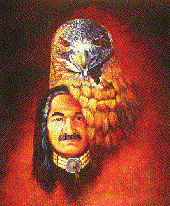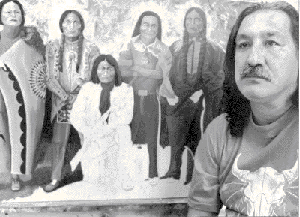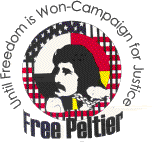
Copyright © Leonard Peltier
Who is Leonard Peltier?
Leonard Peltier is a citizen of the Anishinabe and Lakota Nations who has been unjustly locked behind bars for 25 years. Amnesty International considers him a “political prisoner” who should be “immediately and unconditionally released.” To many Indigenous Peoples, he is a symbol of the long history of abuse and repression they have endured. To the international community, the case of Leonard Peltier is a stain on America’s Human Rights record. Nelson Mandela, Rigoberta Menchu, the U.N. High Commissioner on Human Rights, the Dalai Lama, and Rev. Jesse Jackson are only a few who have called for Peltier’s freedom.
What led to Peltier’s conviction?
It all began in the early 1970’s on the Pine Ridge Indian Reservation when tensions between tribal chairman Dick Wilson and the traditionalists began to escalate. Wilson was pro-assimilation, meaning he believed Native Peoples should discard their traditions to join the mainstream of American society. Traditionalists, on the other hand, felt it important to maintain their culture and remaining land base. Wilson favored those who were also pro-assimilation by giving them jobs and distributing assistance to them while neglecting the needs of the traditionalists who often lived in the worst poverty. The growing conflict prompted traditionalists to join together with the American Indian Movement (AIM), a civil rights group committed to uniting all Native Peoples in an effort to uplift their communities and promote cultural pride and sovereignty. In response, Wilson joined with the FBI to destroy the movement they perceived as a threat to the American way of life. The result was disastrous.
In 1973 local traditionalists and AIM occupied the Pine Ridge hamlet of Wounded Knee to protest the many abuses they were suffering. (This was the same site where, less than 100 years earlier, the horrific Wounded Knee massacre was perpetrated against over 300 Lakotas, mostly women and children.) Instead of listening to the grievances of the Natives, the government responded militarily, firing over 250,000 rounds of ammunition into the area and killing two occupants, whose deaths were never investigated. The occupation lasted 72 days, and ended only after the government promised investigations into the complaints. However, the investigations never materialized and conditions on the reservation worsened.
After Wounded Knee, Wilson outlawed AIM activities on the reservation. Traditionalists were not allowed to meet or attend traditional ceremonies. Wilson hired vigilantes who called themselves Guardians of the Oglala Nation, (or quite literally GOONs), to enforce his rules. The three years following are often referred to as the “Pine Ridge Reign of Terror.” Anyone associated with AIM was targeted. Their homes were burned, they were run off roads, run over by cars, shot in drive by shootings, and beaten. Between 1973 and 1976 over 60 traditionalists were murdered, resulting in the highest murder rate in the U.S. Scores more were assaulted. In almost every case, witness accounts indicated GOON responsibility, but nothing was done to stop the violence. Meanwhile, the FBI supplied the GOON squads with weaponry and intelligence information on AIM, and looked away as they committed crimes.
As the situation worsened, the traditionalists asked AIM to return to the reservation to offer protection. Leonard Peltier was among those who responded. He and a group of a dozen others set up camp on the Jumping Bull ranch, the home of a number of traditional families.
On June 26, 1975 two FBI agents in unmarked cars pursued a red pickup truck onto the land. They were ostensibly looking for Jimmy Eagle, who had gotten into a fistfight and stolen a pair of cowboy boots. (The agents had in their possession a map, which labeled the families’ storage cellars “bunkers.”)
Shots rang out, and the residents became alarmed. While mothers fled the area with their children, others started to return fire and a shoot-out erupted. Law enforcement immediately began mobilizing. Sightings of the red pickup truck leaving the scene were transmitted by radio, but the truck was never apprehended. Within a couple hours, over 150 FBI swat team members, BIA police, and GOONs had surrounded the ranch. Peltier helped lead a small group of teenagers out of the area, barely escaping through the hail of bullets. When the shoot-out ended, AIM member Joseph Killsright Stuntz laid dead, shot in the head by a sniper. His death was never investigated. The two agents also lay dead, wounded in the gun battle, then shot at point blank range. According to FBI documents, over 40 Native people participated in the shoot-out, both AIM and non-AIM. Yet only four were indicted for the deaths of the agents. They included AIM leaders Dino Butler, Bob Robideau, and Leonard Peltier, as well as Jimmy Eagle. Butler and Robideau were arrested first and went to trial. They were found innocent on grounds of self-defense. They could not be tied to the point blank shootings, and the jury found that returning fire was justified under the circumstances of that time period. The FBI was outraged with the verdict. They dropped charges against Eagle so they could “put the full prosecutive weight of the U.S. government on Leonard Peltier,” according to their own memos.
Peltier, meanwhile, had fled to Canada believing he would never receive a fair trial. On February 6, 1976 he was apprehended. The FBI presented the Canadian court with affidavits from a woman named Myrtle Poor Bear. She claimed to have been Peltier’s girl friend, and to have witnessed him shoot the agents. In fact, she had never met Peltier, nor was she present at the time of the shooting. Soon after, she confessed she had given the false statements after being terrorized by FBI agents. Despite this, the extradition was not reversed.
How was Peltier’s trial unfair?
Leonard Peltier was returned to the U.S. where his case was mysteriously transferred from the judge who tried his co-defendants, to a different judge, who made rulings, which severely handicapped the defense. For example, he banned Myrtle Poor Bear and other key witnesses from testifying. Testimony about the Pine Ridge Reign of Terror was tightly restricted. The red pick-up truck, which had been followed onto the ranch and was later seen leaving the scene by the FBI, was suddenly described as a red and white van, a vehicle which Peltier sometimes drove. Radio transmissions proving the vehicle to be a pick-up, not a van, were withheld. Three young Native witnesses were forced to testify against Peltier after being detained and terrorized by the FBI. Their testimony was inconsistent and self-contradictory, yet damaging nonetheless. Still no one named Peltier as the shooter. The government’s most condemning evidence was a ballistic test that tied Peltier’s alleged gun to a critical bullet casing found in the trunk of the agents’ car. However, years later, a Freedom of Information Act suit would release documents proving the casing in fact did not match and the FBI intentionally concealed the contradictory ballistic report. The jury never knew about any of these abuses and Peltier was unfairly convicted and condemned to two consecutive life sentences.
After many of these abuses surfaced, a new trial was demanded. During court proceedings the U.S. Prosecutor admitted “I can’t prove who shot those agents.” The court found that Peltier may have been acquitted had evidence not been improperly withheld by the FBI. Yet a new trial was denied on a legal technicality. Judge Heaney, who authored the decision, has since expressed firm support for Peltier’s release through executive clemency.
In 1993 Peltier requested clemency from President Clinton. An intensive campaign was launched and supported by Native and human rights organizations, members of Congress, the international community, church groups, labor organizations, luminaries, and celebrities, escalating into a national issue. On November 7, 2000 during a live interview, Amy Goodman of WBAI asked Clinton his position on Peltier’s clemency. He responded that he would seriously consider the request and make a decision before leaving office. In response, the FBI launched a major disinformation campaign in both the media and among key officials. On December 15, 2000 over 500 FBI agents marched in front of the White House to oppose clemency. On January 20, 2001 (Clinton’s last day in office) Leonard Peltier’s name was not included on Clinton’s list of clemencies. No explanation was given.
For over ten years Peltier has been eligible for parole. However, prior to each parole hearing, the FBI meets with the Parole Commission to voice objection to Peltier’s release. After every hearing, parole is denied without justification. The FBI has consistently obstructed justice in this case and must be held accountable. The deaths of their agents was indeed tragic, but the imprisonment of an innocent man cannot be tolerated.
Where is Peltier’s case now?
We are urging the U.S. Congress to hold hearings on the Peltier case and to pass an act to declassify the 6000 documents still being withheld by the FBI for reasons of national security. We believe the information in these documents could overturn Peltier’s conviction. We are also awaiting a ruling on a pending law suit filed against the Parole Commission for unjustly denying Peltier’s release.
How can I help?
1. Write letters, make phone calls, and fax your Representatives in the House and Senate. Ask them to both support an investigation into this case and support the declassification of the 6000 documents. To find out who your representatives are and how to contact them, call the Congressional switchboard: 202-224-3121 or visit: www.vote-smart.org
2. Help educate others about the Peltier case. Write letters to the editor in your local paper, hold video showings, and distribute literature in your area. Contact us for resources. COPY AND DISTRIBUTE THIS PAGE!
3. Donate to the LPDC and help fund our efforts. The LPDC is the center of communication between Leonard Peltier, his supporters, the media, key officials, his attorneys, and his family. The LPDC facilitates the national campaign to gain Mr. Peltier’s release. Your support is needed & appreciated!
4. Write to Leonard directly. Leonard Peltier #89637-132, Box 1000, Leavenworth, KS 66048.
To learn more about Leonard Peltier’s case:
VIDEOS
Incident at Oglala by Robert Redford
(obtain through LPDC or rent locally)
Warrior by Suzie Baer
(Cinnamon Productions: 203-221-0613)
Year 2000 Congressional Briefing
(obtain through the LPDC)
Spirit of Crazy Horse
(obtain through PBS: 1-800-playPBS, order # A-1845 )
BOOKS
Prison Writings-My Life is my Sundance,
by Leonard Peltier(can be obtained through the LPDC)
In the Spirit of Crazy Horse, by Peter Matthiessen
(can be obtained through LPDC)
The Trial of Leonard Peltier, Jim Messerschmidt
(can also be obtained through LPDC)
Agents of Repression, the FBI’S Secret Wars Against
the Black Panther Party and the American Indian Movement,
&
The COINTELPRO Papers: Documents in the United States,
Churchill and Vander Wall 800-533-8478
Blood of the Land: The Government and Corporate
War Against First Nations, Rex Wyler
FOR UPDATES VISIT OUR WEB SITE: www.freepeltier.org &
SUBSCRIBE TO: “Spirit of Crazy Horse”
(bi-monthly newspaper)
NATIONAL……………………20.00 year
SENIOR CITIZEN…………… 10.00 year
PRISONER…………………… FREE
INTERNATIONAL…………… 30.00 year
(Check or money order, U.S. funds ONLY)
LEONARD PELTIER DEFENSE COMMITTEE
PO BOX 583 -- LAWRENCE, KS 66044
785-842-5774 Fax: 785-842-5796
In the Atlanta area, contact:
Leonard Peltier Support Group, Atlanta
471 Seminole Ave, NE
Atlanta, GA 30307
404-525-4360
email: freejoye@mindspring.com
IT’S NOW THE YEAR 2002!
WHY IS LEONARD STILL IN PRISON?


